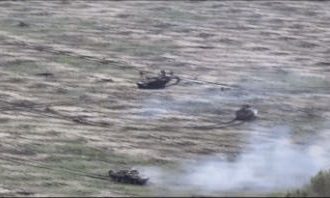Stay informed with free updates
Simply sign up to the War in Ukraine myFT Digest — delivered directly to your inbox.
Ukrainian forces have established several fortified bridgeheads on the Russian-occupied left bank of the Dnipro river in their most significant territorial gains for weeks in their otherwise stalled counteroffensive.
Ukraine’s military confirmed the advances in a statement on Friday without naming where they were.
“The Ukrainian marines, in co-operation with other units of the defence forces, managed to gain a foothold on several bridgeheads,” read the statement.
Russia also acknowledged the Ukrainian presence for the first time. Vladimir Saldo, the Moscow-appointed governor of Russian-occupied Kherson province, said on Telegram that Ukrainian forces were in one area, near the village of Krynky — 18 miles north-east of Kherson city.
A western official on Thursday said Ukraine had moved “elements of three brigades” to the Russian-occupied east bank of the river, and confirmed reports last week by Russian military bloggers that Ukraine has moved some vehicles across.
A brigade typically numbers 2,000 to 5,000 soldiers but the official said the Ukrainian contingent probably consisted of “hundreds”.

The western official said Russian forces had not been able to push them back and the Ukrainians had established a “significant foothold” in the area.
Ukrainian forces liberated Kherson city a year ago, pushing the Russian forces across the Dnipro river, where they fortified their positions. The wide waterway has become the frontline, given the difficulty for Ukraine to ferry men and equipment across the water under threat of Russian artillery fire.
Soon after freeing Kherson city, Ukraine began launching reconnaissance raids, stepping up operations in the spring. Over summer, western military analysts and Britain’s defence ministry reported that Ukraine had established a bridgehead position at the Antonivskyi bridge, near Kherson city. This advance may have partly been enabled by the destruction of the Khakovka dam in June, which led to the land around the bridge drying up, according to analysts.
Ukraine’s general staff on Friday said its forces had conducted multiple “successful” reconnaissance raids and actions, gathering intelligence on enemy supply routes and destroying Russian positions and equipment.
It said one of the main aims of the operation was to push Russian forces further back from the river bank, from where they had been shelling Kherson city for months.
Ukrainian forces were likely to build out their bridgehead positions slowly and then proceed in small steps with the aim of stretching Russian forces along the frontline rather than conduct a main counteroffensive thrust, the official said. The aim was probably to force Russian commanders to divert forces from other hotspots along the frontline.
The Ukrainian general staff said Russian forces were trying to “knock out” Ukrainian positions four to 10 times a day, were consequently suffering heavy losses and were being forced to transfer troops from elsewhere on the frontline.
In its statement on Friday, Ukraine’s marines claimed the river bank operations had so far cost Russia dozens of pieces of heavy equipment, more than a thousand personnel as well as other weaponry.
Russian military bloggers said there were ongoing battles in two other areas in north-east Kherson region, about seven and nine miles from Kherson city, according to the Washington-based Institute for the Study of War.
Saldo said Ukraine’s forces were also taking heavy losses and Ukraine’s operation was resulting in a “flow” of Ukrainian prisoners of war.
The claims of losses suffered by either side could not be independently verified.
Read the full article here




